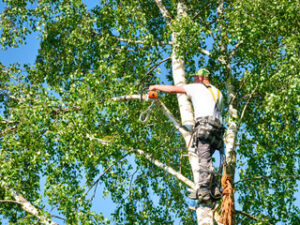Gutter Repair Baltimore is a necessary part of homeowner maintenance. Regular cleaning can help prevent clogs, leading to other problems that can be costly to fix.
While some gutter repairs can be done as a DIY project, it is recommended that a professional be hired for more extensive work, such as realignment and reinforcement.

Gutter sagging can lead to water overflowing the gutter, backing up under the fascia boards, and possibly seeping through the basement window wells or even into the home’s foundation. Fortunately, gutters can be repaired to restore their proper slope and prevent water damage. The first step is to examine the cause of sagging. It could be an accumulation of debris, or the gutters may be loose or damaged.
While performing your routine cleaning of the gutters, pay special attention to areas where the sagging is most prominent. These are likely the sections that need to be fixed. A close inspection will reveal the problem with the gutters, which is often due to missing or broken hangers or fasteners.
Gutter hangers are long metal clips that attach to the side of the gutter, holding it firmly to the fascia board. These are easily inspected and replaced from the ground or by climbing a ladder to inspect the gutters. Look for crooked, rusty or bent hangers that need to be replaced. Gutter hangers are typically made of aluminum, which is resistant to corrosion, but if the gutters are older they may be made of galvanized steel.
The other common cause of sagging is the downspout system. Whether it’s the downspout itself or the downspout outlet that’s blocked, this will cause the gutters to become extremely heavy. The gutters themselves are not able to support the excess weight and will begin to sag, especially in the area closest to the blockage.
If the downspout itself is the issue, a professional gutter company can install a new downspout that’s designed to drain water more efficiently than the old one. The gutters themselves can also be repaired to eliminate sagging by filling in holes or repairing damaged corners and seams with roofing cement. The gutters may also be re-leveled to correct the sagging if the issue is caused by a misaligned gutter system or improper installation. If the gutters are beyond repair, they may need to be replaced entirely. A professional gutter company can help you determine which options are the best for your home.
Loose or Damaged Fasteners
Gutters are an integral part of your home, helping to keep water from damaging the interior and exterior of your house. However, like many other aspects of your home, they are subject to wear and tear from everyday use and weathering. Over time, this can lead to damage, requiring you to make gutter repairs or even replace them entirely.
One of the most common causes of damage to gutters is loose or damaged fasteners. This is because a number of environmental factors can cause the fasteners to loosen, which can result in the deterioration or even the failure of your gutters.
The most common type of fastener used in gutter systems is the gutter spike, which consists of a metal spike that clips into the bottom of your gutter section and is then secured by a ferrule. Some homeowners may also use hangers, which are similar in nature to the spike but attach directly to the fascia board of your roof.
These fasteners can be loosened by over tightening, which can lead to stripped threads that will no longer hold the two components together. In addition to this, fasteners can become loose because of corrosive agents that attack them. The good news is that most fasteners can be saved by re-tightening or using non-destructive inspection techniques such as dye penetrant testing.
Dripping Downspouts
Gutter downspouts are designed to carry water away from a house. However, a downspout that is too small to handle the volume of rainwater it receives can overflow or even break from excessive stress. If this happens, your gutters may need to be extended. This is a relatively simple DIY project that can help ensure your gutter system works properly and protects the structure of your home.
If you’re noticing a dripping downspout, it’s important to find the source of the problem quickly before it escalates. The cause could be a number of issues, from rusted fasteners to loose brackets. To prevent the problem from spreading, it’s a good idea to inspect your gutters on a regular basis and make any necessary repairs immediately.
Dripping downspouts can often be repaired by using silicone caulk. Apply a thin bead of caulk to the joint where the downspout connects to the gutter. Be sure to clean the area before applying caulk, and it’s best if you do this project on a warm day so that it adheres well.
Downspouts can also become clogged with debris. This is a common problem that can lead to gutter overflow and other issues. You can often determine if your downspout is clogged by getting on a ladder after a rainstorm and tap down on it along its length. A clogged gutter will sound hollow, while one that is flowing freely will emit a higher-pitched noise.
In some cases, a downspout can simply be overflowing due to an improper pitch. If you notice that the water is moving faster than it should be, you may need to have the gutter re-pitched so that it’s pitched correctly to move the water away from the house.
Downspouts can also become tangled with trees and other debris. If this is the case, you may need to use a metal downspout extension to get the water to flow correctly. This is a relatively easy project that any homeowner can do on their own, and it’s a great way to ensure your gutters work properly and keep your home protected from costly foundation damage.
Damaged Gutters
Gutters that get damaged can be costly to repair and even more damaging if left unattended. Damaged gutters can lead to water leakage which, if not addressed promptly, can cause mold, wood rot and structural damage to the home or building. Damaged gutters can also encourage further deterioration through electrolytic corrosion, where the metal gradually etches away. Taking proactive steps to regularly inspect and clean your gutters while upgrading to gutter guards can help avoid this problem altogether.
Gutter guards are a good investment for homeowners as they can reduce debris build-up significantly, and can help keep your gutters looking like new for years to come. However, even with the best gutter guards in place, gutter repairs are often necessary as it is impossible to completely protect your gutters from weather and environmental factors that can lead to damage over time.
The most common types of damage to gutters include holes, cracks and rust. Gutter holes can occur when sharp branches fall against the gutters or through corrosion of the metal. Gutter cracks can happen through erosion of the gutter material, or when the gutter is pushed inwards due to sagging or loose sections. Rust can also weaken the gutter material, leading to further deterioration and damage.
Inspect the gutters for cracks and holes on a regular basis, especially after heavy storms or during the winter. Small cracks and holes can be repaired using a patch or sealant, and larger ones may need to be replaced.
If you spot a hole or crack in your gutters, first clean the area with a wire brush and a rag soaked in mineral spirits. Wearing leather work gloves, scrape off any rust that has formed around the hole. If the hole is in a section of your gutter that is not rusted through, you can use a sheet of wire screening and some roof cement to fix it.
If the hole is in a rusty section of gutter, you may need to replace that entire section. Depending on the type of gutter you have, this can be done with sleeve-and-spike supports, fascia brackets nailed to the face of the wall or strap hangers nailed to the gutter.








